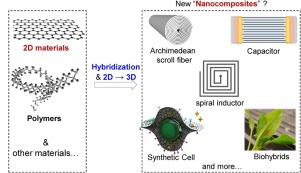当前位置:
X-MOL 学术
›
Nano Today
›
论文详情
Our official English website, www.x-mol.net, welcomes your feedback! (Note: you will need to create a separate account there.)
Emerging trends in 2D nanotechnology that are redefining our understanding of “Nanocomposites”
Nano Today ( IF 17.4 ) Pub Date : 2018-08-01 , DOI: 10.1016/j.nantod.2018.04.012 Pingwei Liu , Anton L. Cottrill , Daichi Kozawa , Volodymyr B. Koman , Dorsa Parviz , Albert Tianxiang Liu , Jingfan Yang , Thang Q. Tran , Min Hao Wong , Song Wang , Michael S. Strano
Nano Today ( IF 17.4 ) Pub Date : 2018-08-01 , DOI: 10.1016/j.nantod.2018.04.012 Pingwei Liu , Anton L. Cottrill , Daichi Kozawa , Volodymyr B. Koman , Dorsa Parviz , Albert Tianxiang Liu , Jingfan Yang , Thang Q. Tran , Min Hao Wong , Song Wang , Michael S. Strano

|
Abstract The goal of this review is to summarize the recent development of nanocomposites of 2D materials, especially polymer nanocomposites with large-area, high-quality 2D sheets, and more importantly, the future direction of this field. Scientists and engineers have a tendency to review and envision the future based on the past, but innovation does not work like this. Herein, we do not provide a comprehensive review of nanocomposites with 2D materials; rather, we highlight unusual or unconventional directions emerging for nanocomposite materials research. This forward-looking perspective of current trends focuses on new research directions. In this review, we summarize the fundamentals of nanocomposites in regards to the mechanical and functional reinforcement at the theoretical limit, and we briefly introduce the synthesis of large-area 2D materials with high quality and their controlled dispersion into matrix materials to achieve the maximum reinforcement predicted by theory. We continue with the classical and fundamentally important problem of the mechanical reinforcement in nanocomposites; that is, does the reinforcing contribution come from the modification of matrix or the direct mechanical reinforcement by the nanofillers? We present and discuss new forms of nanocomposites with layered and scrolled structure and well-positioned, semi-infinite 2D layers in detail. We also address the functional reinforcement from the continuous 2D sheets and the unusual applications of nanocomposites enabled by these functional 2D layers. In particular, we discuss fiber devices, such as an electromagnetic inductor and a thermal spiral conductor, an atomic-thick barrier film, a bioactive hybrid via attaching 2D layers to a living organism such as plant leaves, intelligent particle devices acting as state machines, and optical devices such as single photon emitters. With these, we further introduce the new nanocomposite concept of a three-dimensional (3D) macroscopic nanocomposite body comprised exclusively of 2D topology. Finally, we discuss the scalability challenges of the production process and the outlook of potential solutions. We hope this review and perspective can intrigue researchers who are currently working in the fields of 2D materials, polymers, and nanocomposites and provide some new insights to promote the future development of nanocomposites.
中文翻译:

二维纳米技术的新兴趋势正在重新定义我们对“纳米复合材料”的理解
摘要 本综述的目的是总结二维材料纳米复合材料的最新发展,尤其是具有大面积、高质量二维片材的聚合物纳米复合材料,更重要的是,该领域的未来发展方向。科学家和工程师倾向于根据过去回顾和展望未来,但创新并非如此。在此,我们不提供具有 2D 材料的纳米复合材料的全面评论;相反,我们强调了纳米复合材料研究中出现的不同寻常或非常规的方向。这种对当前趋势的前瞻性视角侧重于新的研究方向。在这篇综述中,我们总结了纳米复合材料在理论极限下的机械和功能增强的基本原理,我们简要介绍了高质量的大面积二维材料的合成及其在基体材料中的受控分散,以实现理论预测的最大增强。我们继续研究纳米复合材料中机械增强的经典和基本重要问题;也就是说,增强贡献是来自基体的改性还是来自纳米填料的直接机械增强?我们详细介绍并讨论了具有分层和滚动结构以及位置良好的半无限二维层的新型纳米复合材料。我们还解决了连续 2D 片材的功能增强以及由这些功能 2D 层实现的纳米复合材料的不寻常应用。我们特别讨论光纤设备,例如电磁感应器和热螺旋导体、原子厚度的屏障膜、通过将 2D 层连接到活的有机体(例如植物叶子)的生物活性混合物、充当状态机的智能粒子设备以及光学设备(例如单光子发射器) . 有了这些,我们进一步介绍了仅由 2D 拓扑组成的三维 (3D) 宏观纳米复合材料体的新纳米复合材料概念。最后,我们讨论了生产过程的可扩展性挑战和潜在解决方案的前景。我们希望这篇综述和观点能够引起目前在二维材料、聚合物和纳米复合材料领域工作的研究人员的兴趣,并提供一些新的见解,以促进纳米复合材料的未来发展。通过将 2D 层连接到活的有机体(例如植物叶子)、充当状态机的智能粒子设备和光学设备(例如单光子发射器)来实现生物活性混合。有了这些,我们进一步介绍了仅由 2D 拓扑组成的三维 (3D) 宏观纳米复合材料体的新纳米复合材料概念。最后,我们讨论了生产过程的可扩展性挑战和潜在解决方案的前景。我们希望这篇综述和观点能够引起目前在二维材料、聚合物和纳米复合材料领域工作的研究人员的兴趣,并提供一些新的见解,以促进纳米复合材料的未来发展。通过将 2D 层连接到活的有机体(例如植物叶子)、充当状态机的智能粒子设备和光学设备(例如单光子发射器)来实现生物活性混合。有了这些,我们进一步介绍了仅由 2D 拓扑组成的三维 (3D) 宏观纳米复合材料体的新纳米复合材料概念。最后,我们讨论了生产过程的可扩展性挑战和潜在解决方案的前景。我们希望这篇综述和观点能够引起目前在二维材料、聚合物和纳米复合材料领域工作的研究人员的兴趣,并提供一些新的见解,以促进纳米复合材料的未来发展。有了这些,我们进一步介绍了仅由 2D 拓扑组成的三维 (3D) 宏观纳米复合材料体的新纳米复合材料概念。最后,我们讨论了生产过程的可扩展性挑战和潜在解决方案的前景。我们希望这篇综述和观点能够引起目前在二维材料、聚合物和纳米复合材料领域工作的研究人员的兴趣,并提供一些新的见解,以促进纳米复合材料的未来发展。有了这些,我们进一步介绍了仅由 2D 拓扑组成的三维 (3D) 宏观纳米复合材料体的新纳米复合材料概念。最后,我们讨论了生产过程的可扩展性挑战和潜在解决方案的前景。我们希望这篇综述和观点能够引起目前在二维材料、聚合物和纳米复合材料领域工作的研究人员的兴趣,并提供一些新的见解,以促进纳米复合材料的未来发展。
更新日期:2018-08-01
中文翻译:

二维纳米技术的新兴趋势正在重新定义我们对“纳米复合材料”的理解
摘要 本综述的目的是总结二维材料纳米复合材料的最新发展,尤其是具有大面积、高质量二维片材的聚合物纳米复合材料,更重要的是,该领域的未来发展方向。科学家和工程师倾向于根据过去回顾和展望未来,但创新并非如此。在此,我们不提供具有 2D 材料的纳米复合材料的全面评论;相反,我们强调了纳米复合材料研究中出现的不同寻常或非常规的方向。这种对当前趋势的前瞻性视角侧重于新的研究方向。在这篇综述中,我们总结了纳米复合材料在理论极限下的机械和功能增强的基本原理,我们简要介绍了高质量的大面积二维材料的合成及其在基体材料中的受控分散,以实现理论预测的最大增强。我们继续研究纳米复合材料中机械增强的经典和基本重要问题;也就是说,增强贡献是来自基体的改性还是来自纳米填料的直接机械增强?我们详细介绍并讨论了具有分层和滚动结构以及位置良好的半无限二维层的新型纳米复合材料。我们还解决了连续 2D 片材的功能增强以及由这些功能 2D 层实现的纳米复合材料的不寻常应用。我们特别讨论光纤设备,例如电磁感应器和热螺旋导体、原子厚度的屏障膜、通过将 2D 层连接到活的有机体(例如植物叶子)的生物活性混合物、充当状态机的智能粒子设备以及光学设备(例如单光子发射器) . 有了这些,我们进一步介绍了仅由 2D 拓扑组成的三维 (3D) 宏观纳米复合材料体的新纳米复合材料概念。最后,我们讨论了生产过程的可扩展性挑战和潜在解决方案的前景。我们希望这篇综述和观点能够引起目前在二维材料、聚合物和纳米复合材料领域工作的研究人员的兴趣,并提供一些新的见解,以促进纳米复合材料的未来发展。通过将 2D 层连接到活的有机体(例如植物叶子)、充当状态机的智能粒子设备和光学设备(例如单光子发射器)来实现生物活性混合。有了这些,我们进一步介绍了仅由 2D 拓扑组成的三维 (3D) 宏观纳米复合材料体的新纳米复合材料概念。最后,我们讨论了生产过程的可扩展性挑战和潜在解决方案的前景。我们希望这篇综述和观点能够引起目前在二维材料、聚合物和纳米复合材料领域工作的研究人员的兴趣,并提供一些新的见解,以促进纳米复合材料的未来发展。通过将 2D 层连接到活的有机体(例如植物叶子)、充当状态机的智能粒子设备和光学设备(例如单光子发射器)来实现生物活性混合。有了这些,我们进一步介绍了仅由 2D 拓扑组成的三维 (3D) 宏观纳米复合材料体的新纳米复合材料概念。最后,我们讨论了生产过程的可扩展性挑战和潜在解决方案的前景。我们希望这篇综述和观点能够引起目前在二维材料、聚合物和纳米复合材料领域工作的研究人员的兴趣,并提供一些新的见解,以促进纳米复合材料的未来发展。有了这些,我们进一步介绍了仅由 2D 拓扑组成的三维 (3D) 宏观纳米复合材料体的新纳米复合材料概念。最后,我们讨论了生产过程的可扩展性挑战和潜在解决方案的前景。我们希望这篇综述和观点能够引起目前在二维材料、聚合物和纳米复合材料领域工作的研究人员的兴趣,并提供一些新的见解,以促进纳米复合材料的未来发展。有了这些,我们进一步介绍了仅由 2D 拓扑组成的三维 (3D) 宏观纳米复合材料体的新纳米复合材料概念。最后,我们讨论了生产过程的可扩展性挑战和潜在解决方案的前景。我们希望这篇综述和观点能够引起目前在二维材料、聚合物和纳米复合材料领域工作的研究人员的兴趣,并提供一些新的见解,以促进纳米复合材料的未来发展。



























 京公网安备 11010802027423号
京公网安备 11010802027423号